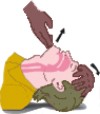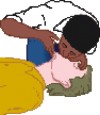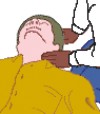|
Tip-Off
In
Case of Emergency
Electrical
shock first aid
Babies and toddlers are eye level to electrical outlets and
like to poke objects in them. Most parents have the outlets
covered, but what do you do if your child's gets curious at
a home where they are not covered and pokes a screwdriver
into the outlet? Or perhaps they are playing with a wire that
is old and coming apart, they stick it into their mouth and
are getting shocked. A severe electric shock may knock a child
unconscious, burn them, cause internal damage and may stop
breathing. A mild shock may simply hurt and scare them. This
article is what to do in severe shock cases.
If
your child is getting an electrical shock your first instinct
is to grab them away from the current but don't! You will
be joined into the electrical current and not be able to help
your child. Your first step is to switch the current off,
if you can. If this is not possible, you need to get a non-conductive
item like a wooden stick or a broom handle and push away or
lift off the source of the current. Push it far enough away
so that it won't re-conduct, then quickly run back to the
victim.
Now
that the current is disconnected from your child, check to
see if they are breathing. To do this put your finger under
the jaw to feel a pulse and your ear by their nose, watch
for the rise and fall of their chest. If they are not breathing
start Cardio Pulmonary Resucitation and call for emergency
medical help.
If
they are breathing you should take them into the emergency
room for an examination. There can be internal injuries that
you can not see, even if the external burn looks minor. You
can treat the burn if it looks minor like a normal burn. But,
going to the emergency room should preclude this if it was
a severe shock.
Electrical
fires are different than other fires. Because water conducts
electricity, throwing water on an electrical fire can cause
the fire to get larger. Here is what to do:
1. NEVER use water on an electrical fire.
2. Tell an adult to turn off the main power to the house.
3. If the fire can be put out safely, tell an adult to use
a proper chemical fire extinguisher. If the fire cannot be
put out safely, leave the house and take everyone with you.
4. Call 199 or 9555555 and tell them it is an electrical fire.
If
someone has been electrocuted, there's a chance they may still
be in contact with the source of the electricity. Do NOT touch
the person or anything he or she is touching. You could become
part of electricity's path and be shocked or even killed!
Take these three steps:
1. Tell an adult to turn off the main power to the house.
2. Call for help. Tell them it is an electrical accident.
3. When the victim is not in contact with the source of electricity
and you're sure there is no danger, tell an adult to give
first aid for electrical injury. This may include CPR.
4. Don't touch burns, break blisters or remove burned clothing.
Electrical shock may cause burns inside the body, so be sure
the person is taken to a doctor.
Electricity
is always trying to get to the ground. Like all good travellers,
electricity takes shortcuts whenever it can. If something
that conducts electricity gives electricity an easy path to
the ground, electricity will take it!
Source:
SEC.com/ Essortment.com
How
to perform Cardiopulmonary Resuscitation (CPR)
 A
- AIRWAY A
- AIRWAY
*Place victim flat on his/her back on a hard surface.
*Shake victim at the shoulders and shout "are you okay?"
*If no response, call emergency medical system.
*Head-tilt/chin-lift - open victims' airway by tilting their
head back with one hand while lifting up their chin with your
other hand.
 B
- BREATHING B
- BREATHING
*Position your cheek close to victims' nose and mouth, look
toward victims' chest, and
*Look, listen, and feel for breathing (5-10 seconds)
*If not breathing, pinch victim's nose closed and give 2 full
breaths into victim's mouth.
*If breaths won't go in, reposition head and try again to
give breaths. If still blocked, perform abdominal thrusts
(Heimlich maneuver).
 C
- CIRCULATION C
- CIRCULATION
*Check for carotid pulse by feeling for 5-10 seconds at side
of victims' neck.
*If there is a pulse but victim is not breathing, give Rescue
breathing at rate of 1 breath every 5 seconds Or 12 breaths
per minute
*If there is no pulse, begin chest compressions as follows:
*Place heel of one hand on lower part of victim's sternum.
With your other hand directly on top of first hand, Depress
sternum 1.5 to 2 inches.
*Perform 15 compressions to every 2 breaths. (rate: 80-100
per minute) check for return of pulse every minute.
CONTINUE
UNINTERRUPTED UNTIL ADVANCED LIFE SUPPORT IS AVAILABLE.
Source:
Openseason.com/healthclub/cpr
Copyright
(R) thedailystar.net 2004
| 